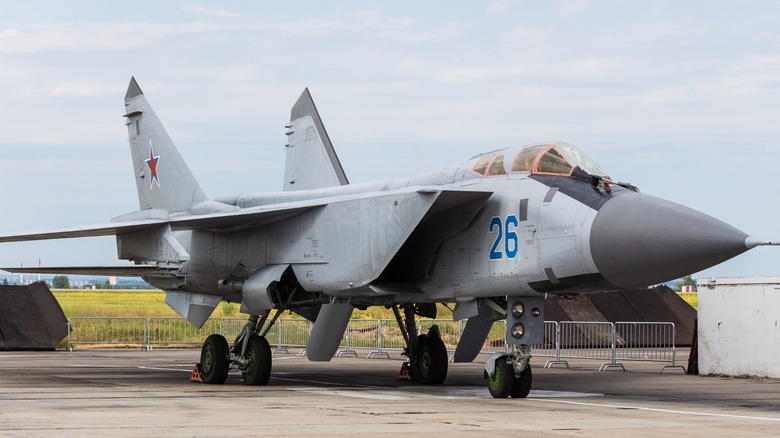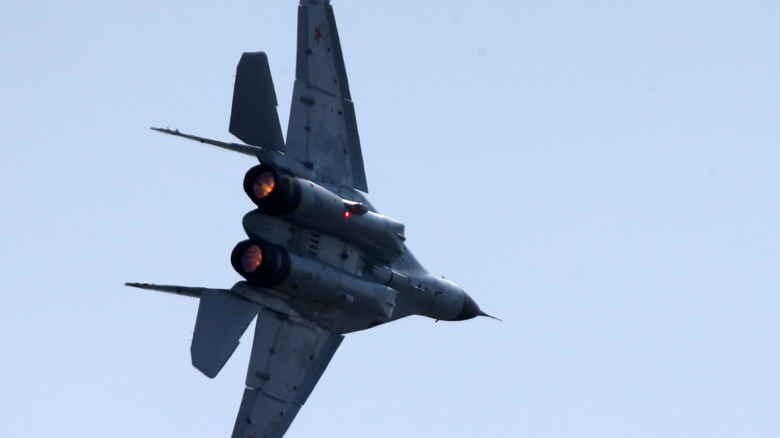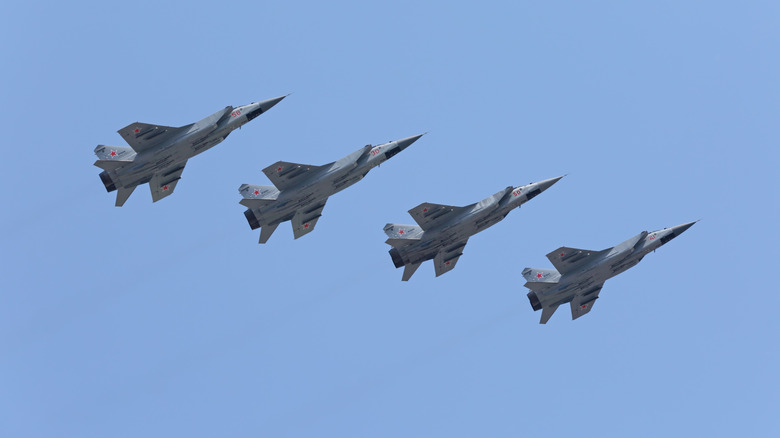Everything We Know About Russia's Futuristic MiG-41 Fighter Jet
Today's modern crop of fifth-generation fighter jets, like the F-22 Raptor, F-35 Lightning 2, and the Russian SU-57, are the most advanced warplanes to hit the skies. But something happened in 2018 that inadvertently kickstarted the race to develop an all-new, sixth-generation aircraft that would give Raptor and Lightning pilots something to think about. That year, the Russian TASS news agency reported that the Ministry of Defense wanted to develop a "long-range interception aircraft" to replace its aging Mig-31 fighter jets (pictured above), relics of the Cold War.
According to the Eurasian Times, Russia's military aircraft arm Mikoyan Gurevich started working on the MiG-41 PAK DP program in 2013. The MiG-41 concept will replace the venerable MiG-31 Foxhound as Russia's premiere air interceptor. However, the details are expectedly scarce for Russia's newest top-secret fighter jet. If the rumors are true, the MiG-41 PAK DP (Prospective Air Complex for Long-Range Interception) will shatter all expectations with its hi-tech capabilities.
MiG-41 PAK DP: Fastest jet in the world?
The incoming MiG-41 PAK DP fighter jet has enormous shoes to fill. The MiG-31 is not exactly a slow poke with its Mach 2.3 cruising speed and Mach 2.8 max velocity. It has a body of steel, aluminum, and titanium to withstand the rigors of supersonic flight. What's more, some variations of the MiG-31 could fire hypersonic missiles while having a 1,800-mile range before refueling.
The fourth-gen MiG-31 Foxhound has received comprehensive updates since entering service in 1975. In addition, the Russian Ministry of Defense has invested in a hefty modernization program in 2020 to keep the Foxhound airworthy against fifth-gen jet fighters. However, the MiG-31 will remain in service as its successor, the MiG-41 PAK DP, takes its maiden voyage by 2025 and enter service by 2028.
And when it does, the MiG-41 will have an array of eye-raising features. For instance, it could become the world's fastest military aircraft, capable of cruising at four times the speed of sound (Mach 4 or 4,939 kph) and operate near space, enough to outclass Lockheed Martin's SR-71 Blackbird. Furthermore, by all reports, it will be invisible on the radar and could intercept bombers, cruise missiles, and drones with its proprietary weapons and hypersonic projectiles.
Is the MiG-41 too good to be true?
Russian scientists and engineers have many hurdles to overcome to prove that the MiG-41 PAK DP project is more than vaporware. First, sustained supersonic flight requires lots of fuel, and carrying tons of it adds weight. Moreover, flying at Mach 4 produces an unfathomable amount of heat, and extreme temperatures caused by air friction require a new-age material that repels heat while retaining any stealth coating.
Despite talks of funding deficits to compensate for Russia's military activities in Ukraine, the race is on to develop the world's first sixth-gen fighter jet. The United States Air Force has the NGAD (Next Generation Air Dominance) program waiting in the wings, and the Japanese Air Self-Defense Force (JASDF) will have its next-gen fighter jet ready by 2035. Nevertheless, all of what is being reported is theoretically possible, so we'll have to wait and see if the Russian military machine can actually deliver.


